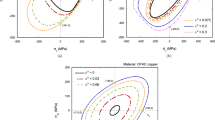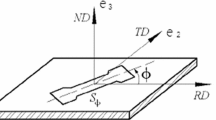Abstract
Influences of preferred orientation on the processes of strain localization which lead to necking failure in biaxial stretching have been investigated in sheets of copper, aluminium and low-carbon steels. With copper having a 0.94 volume fraction of {100}(001) oriented grains, groove formation appeared to be essentially in accord with the predictions of bifurcation theory. However, with more usual sheet textures the effects of preferred orientation on biaxial limit strains depended on the distribution and intensity of plastic inhomogeneities in the microstructure. For copper with a strong {110}(112) textural component, it was shown that crystallographically directed groove formation in biaxial stretching was associated with the large difference in TaylorM factors for plane strain with extension in a (100) direction and for biaxial extension in directions perpendicular to (110). More generally, it was found that the distribution of different components of a texture in the microstructure, and the relative TaylorM factors of segregated components, can have important effects on the rate at which strain localization develops. It was concluded that statistical averages of the distribution of orientations do not provide a sufficient basis for prediction of the effects of preferred orientation on limit strains in biaxial stretching.
Similar content being viewed by others
References
D. V. Wilson, W. T. Roberts, and P. M. B. Rodrigues: (Part I).
R. M. Horta, W. T. Roberts, and D. V. Wilson,Int. J. Mech. Sci., 1970, vol 12, p. 231.
G. Y. Chin,Inhomogeneity of Plastic Deformation, p. 83, ASM, Metals Park, OH, 1973.
R. D. Jenkins and D. V. Wilson,J. Iron Steel Inst., 1971 vol. 209, p. 805.
Z. Marciniak and K. Kuczynski,Int. J. Mech. Sci., 1967, vol. 9, p. 609.
S. Stören and J. R. Rice,J. Mech. Phys. Solids, 1975, vol. 23, p. 421.
H. R. Piehler and W. A. Backofen,Textures in Research and Practice, p. 463, Berlin and New York, Springer, 1969.
I. L. Dillamore, P. Mella, and R. J. Hazel,J. Inst. Met., 1972, vol. 100, p. 50.
G. I. Taylor,J. Inst. Met., 1938, vol. 62, p. 307.
J. F. W. Bishop and R. Hill,Philos. Mag., 1951, vol. 42, pp. 414, 1298.
M. A. Shiekhi Narani,Flow strengths of copper sheets with different textures, Ph.D. Thesis, University of Birmingham, 1978.
G. Y. Chin and W. L. Mammel,Trans. TMS-AIME, 1967, vol. 239, p. 1400.
H. C. Chao,Metall. Trans. A, 1978, vol. 9A, p. 509.
U. Feldman,Practische Metallographie, 1977, vol. 14, p. 289.
W. F. Hosford,Trans. TMS-AIME, 1964, vol. 230, p. 12.
Author information
Authors and Affiliations
Rights and permissions
About this article
Cite this article
Wilson, D.V., Roberts, W.T. & Rodrigues, P.M.B. Effects of grain anisotropy on limit strains in biaxial stretching: part ii. sheets of cubic metals and alloys with well-developed preferred orientations. Metall Trans A 12, 1603–1611 (1981). https://doi.org/10.1007/BF02643566
Received:
Issue Date:
DOI: https://doi.org/10.1007/BF02643566




